Protective Performance of Coated Reinforcement in Coral Concrete under Dry/Wet Cycling
Abstract
:1. Introduction
2. Experimental Overview
2.1. Raw Materials and Mixing Ratio
2.2. Experimental Protocol
3. Experimental Results and Discussion
3.1. Erosion Results and Analysis under the Action of Dry and Wet Cycles
3.2. Electrochemical Testing
3.3. COMSOL Simulation
- (a)
- Model Building
- (b)
- Model parameter setting
- (c)
- Boundary conditions and initial conditions
- (d)
- Boundary conditions and initial conditions
4. Conclusions
- (1)
- The diffusion law of chloride ions in coral concrete under the dry and wet cycle regimes is in accordance with Fick’s second law of diffusion, and a time-varying model of chloride ion diffusion coefficient in coral concrete was established based on several sets of experimental data, through which the chloride ion concentration on the surface of the reinforcement at any time under the dry and wet cycle regimes can be calculated. The Cs value of coral concrete in the dry and wet cycle regimes increased from 0.361% to 0.931% with time. The Cs value of coral concrete increased at a faster rate from 30 to 150 days, and after 150 days, the increase in Cs value continued to decrease and finally remained stable, which can help to predict the service life of coral concrete.
- (2)
- The electrochemical test results show that the corrosion of exposed reinforcement in coral concrete started at 360 days, and that the corrosion resistance of coral concrete without anti-corrosion measures is poor. The Rp value of 3.36 × 106 for coated reinforcement at the 360-day wet and dry cycle time is an order of magnitude greater than the Rp value of 3.14 × 105 for bare reinforcement. The epoxy resin coating remained in the uncorroded state and showed better protection under the dry and wet cycle regimes for one year.
- (3)
- The protection model of CAC-coated reinforced concrete members in natural corrosion conditions at a fine scale was established based on COMSOL. The cathodic zone of the member reacted the most actively, and the potential difference between the cathodic and anodic zones first showed an increasing trend and then decreased with time. It increased from 0 to 20 years from 0 V to 0.14 V, with a large increase in potential difference up to year 7 and a large decrease after year 7.
Author Contributions
Funding
Institutional Review Board Statement
Informed Consent Statement
Data Availability Statement
Acknowledgments
Conflicts of Interest
References
- Gang, W.; Qing, W.; Hao, Z.; Chen, P.; Wei, C. Diffusion of chloride ion in coral aggregate seawater concrete under marine environment. Constr. Build. Mater. 2021, 284, 122821. [Google Scholar]
- Su, L.; Niu, D.; Luo, D. Research of Coral Aggregate Concrete on Mechanical Preperty and Durabiility. Mater. Rep. 2018, 32, 3387–3393. [Google Scholar]
- Huang, X.; Guo, J.; Li, K.; Wang, Z.Z.; Wang, W. Predicting the thermal conductivity of unsaturated soils considering wetting behavior: A meso-scale study. J. Int. J. Heat Mass. Trans. 2023, 204, 123853. [Google Scholar] [CrossRef]
- Zhang, L.; Niu, D.; Wen, B.; Zhang, Y.; Chen, H. Resistivity Model of Modified Coral Aggregate Concrete. Mater. Rep. 2022, 36, 78–83. [Google Scholar]
- Chenggong, C.; Qing, W.; Pinggen, S.; Hao, Z.; Muhammad, A.; Shiliang, M. Study on diffusion of oxygen in coral concrete under different preloads. Constr. Build. Mater. 2022, 319, 126147. [Google Scholar]
- LI, X.; Wu, Q.; Wang, G.; Shi, W.; Wang, S. Electrochemical characteristics of steel corrosion in seawater sea-sand concrete. Concrete 2020, 369, 20–24. [Google Scholar]
- Da, B.; Yu, H.; Ma, H.; Zhang, Y.; Zhu, H.; Yu, Q.; Ye, H.; Jing, X. Factors Influencing Durability of Coral Concrete Structure in the South China Sea. J. Chin. Ceram. Soc. 2016, 44, 253–260. [Google Scholar]
- Akbar, M.; Hussain, Z.; Huali, P.; Imran, M.; Thomas, B.S. Impact of waste crumb rubber on concrete performance incorporating silica fume and fly ash to make a sustainable low carbon concrete. Struct. Eng. Mech. 2023, 85, 275–287. [Google Scholar] [CrossRef]
- Wu, Q.; Wang, G.; Gu, P.; Shi, W.; Li, X.; Xu, Y.; Wang, S. Development of Corrosion Pits on Reinforcement Surface in Coral Concrete under Ocean Environment. China Concr. Cem. Prod. 2020, 286, 5–9. [Google Scholar]
- Da, B.; Yu, H.; Ma, H.; Tan, Y.; Mi, R.; Dou, X. Chloride diffusion study of coral concrete in a marine environment. Constr. Build. Mater. 2016, 123, 47–58. [Google Scholar] [CrossRef]
- Tariq Umar Yousaf, M.; Akbar, M.; Abbas, N. An Experimental Study on Non-Destructive Evaluation of the Mechanical Characteristics of a Sustainable Concrete Incorporating Industrial Waste. Materials 2022, 15, 7346. [Google Scholar] [CrossRef]
- Hongmei, C.; Yutao, L.; Jiwen, G. Research Progress on Durability of Coral Concrete Reinforced with BFRP Bars. Bull. Chin. Ceram. Soc. 2021, 40, 3544–3555. [Google Scholar]
- Wang, Z.Z.; Goh, S.H. A maximum entropy method using fractional moments and deep learning for geotechnical reliability analysis. Acta Geotech. 2022, 17, 1147–1166. [Google Scholar] [CrossRef]
- Kong, G.Q.; Hu, S.J.; Yang, Q. Uncertainty method and sensitivity analysis for assessment of energy consumption of underground metro station. J. Sustain. Cities Soc. 2023, 92, 104504. [Google Scholar] [CrossRef]
- Yao, R. Experimental Study and Analysis of Mechanical Properties of GFRP Reinforcement and Corrosion Resistant Reinforced Marine Concrete Members. Ph.D. Thesis, Guangxi University, Nanning, China, 2021. [Google Scholar]
- Fei, Y.; Wu, Q.; Ma, H.; Yin, R.; Akbar, M.; Yang, N.; Lu, Y.; Lu, K. Study on anti-corrosion performance of composite modified magnesium ammonium phosphate cement-based coatings. J. Build. Eng. 2023, 71, 106423. [Google Scholar] [CrossRef]
- Zhou, Y.; Chen, C.; Cai, J.; Liu, J. Corrosion Behavior of Corrosion Resistant Reinforcing Steels and Their Synergistic Corrosion Resistant Effect with Corrosion Inhibitors. J. Build. Mater. 2016, 19, 379–384. [Google Scholar]
- Wu, Z.; Yu, H.; Ma, H.; Da, B. Detemination of Chloride Threshold Value in Reinforced Coral Aggregate Concrete. J. Build. Mater. 2020, 23, 1078–1085+1092. [Google Scholar]
- Sun, Z.; Niu, D.; Luo, D.; Wang, X.; Zhang, L.; Su, L.; Li, Y. Hybrid machine learning-based prediction model for the bond strength of corroded Cr alloy-reinforced coral aggregate concrete. Mater. Today Commun. 2023, 35, 106141. [Google Scholar] [CrossRef]
- Da, B.; Yu, H.; Ma, H.; Wu, Z. Equivalent Electrical Circuits Fitting of Electrochemical Impedance Spectroscopy for Rebar Steel Corrosion of Coral Aggregate Concrete. J. Chin. Soc. Corros. Prot. 2019, 39, 260–266. [Google Scholar]
- Yu, H.; Da, B.; Ma, H.; Dou, X.; Wu, Z. Service life prediction of coral aggregate concrete structure under island reef environment. Constr. Build. Mater. 2020, 246, 118390. [Google Scholar] [CrossRef]
- Mohit, H.; Rangappa, S.M.; Gapsari, F.; Siengchin, S.; Marwani, H.M.; Khan, A.; Asiri, A.M. Effect of bio-fibers and inorganic fillers reinforcement on mechanical and thermal characteristics on carbon-kevlar-basalt-innegra fiber bio/synthetic epoxy hybrid composites. J. Mater. Res. Technol. 2023, 23, 5440–5458. [Google Scholar] [CrossRef]
- Tang, C. Study on the Application of Zinc Impregnated Steels for Corrosion Protection in Offshore Concrete Structures. Master’s Thesis, Tianjin University, Tianjin, China, 2018. [Google Scholar]
- Yan, Y. Transportation of Chloride Ions in Damaged and Cracked Concrete and Its Action. Ph.D. Thesis, Zhejiang University, Hangzhou, China, 2011. [Google Scholar]
- Zhang, Y.; Zhang, L.; Han, W.; Zhang, Y.; Xie, P. Evaluating the Diffusion Coefficient of Different Epoxy Resins with EIS. Corros. Prot. 2009, 30, 665–668. [Google Scholar]
- Hussain, R.R. Enhanced Classical Tafel Diagram Model for Corrosion of Steel in Chloride Contaminated Concrete and the Experimental Non-Linear Effect of Temperature. Int. J. Concr. Struct. Mater. 2010, 4, 71–75. [Google Scholar]
- Fang, J. Mechanism and Simulation Study of Steel Bar Corrosion in Concrete Exposed to Chloride Environment. Master’s Thesis, Zhejiang University, Hangzhou, China, 2017. [Google Scholar]
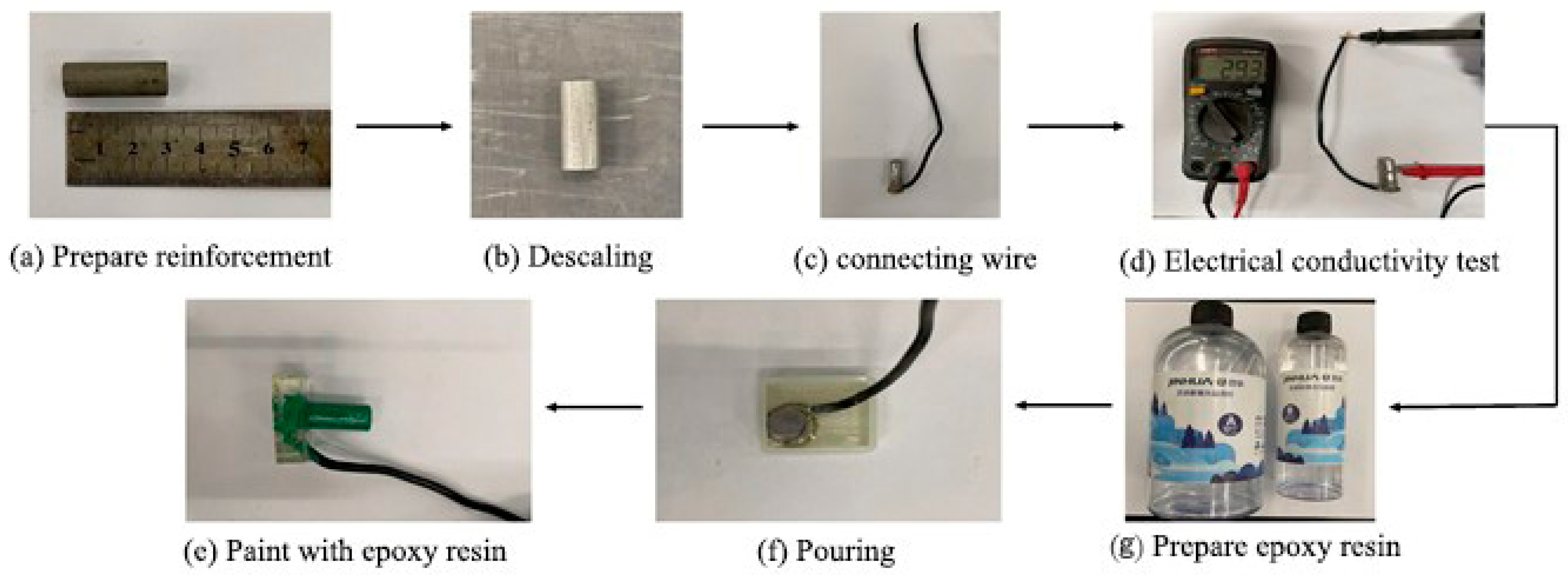
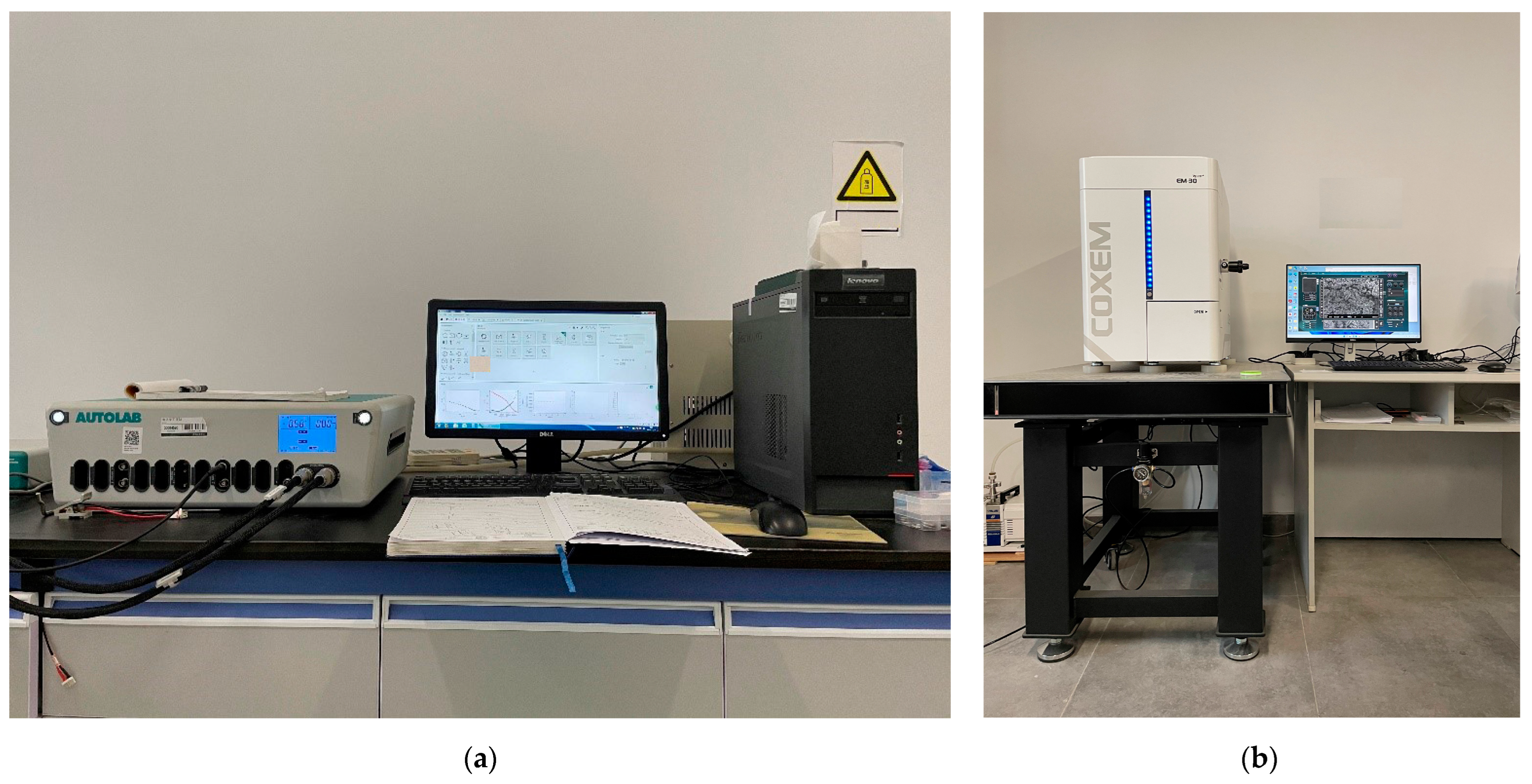
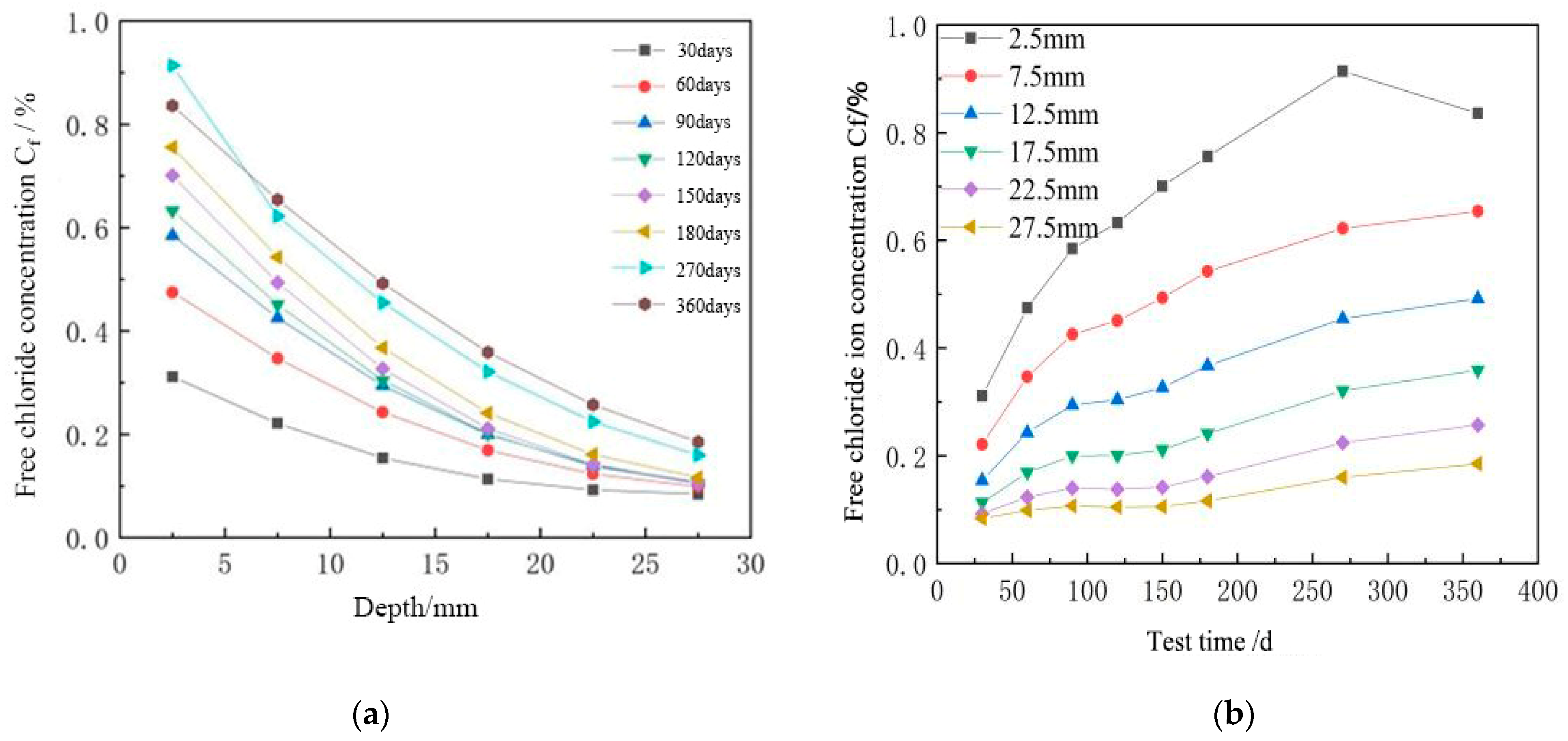
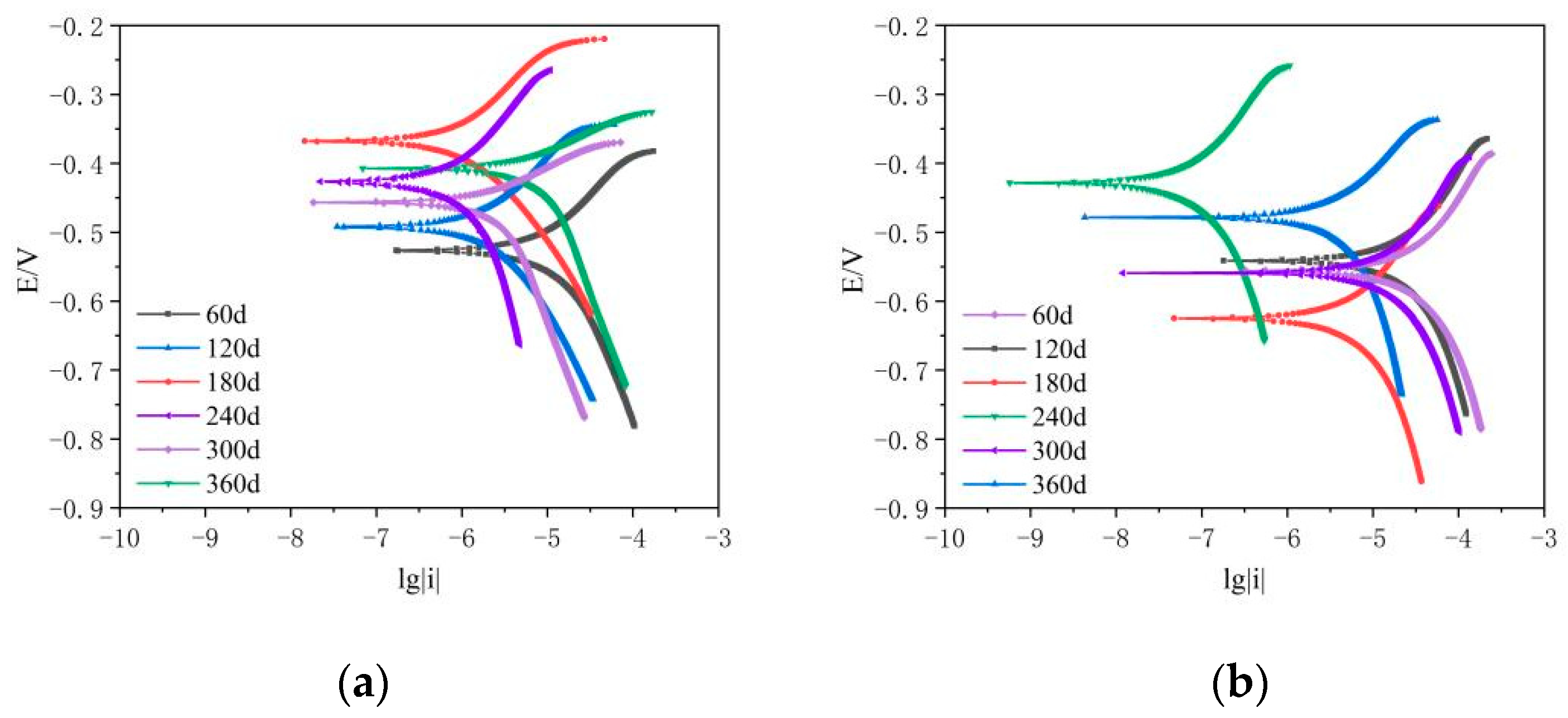



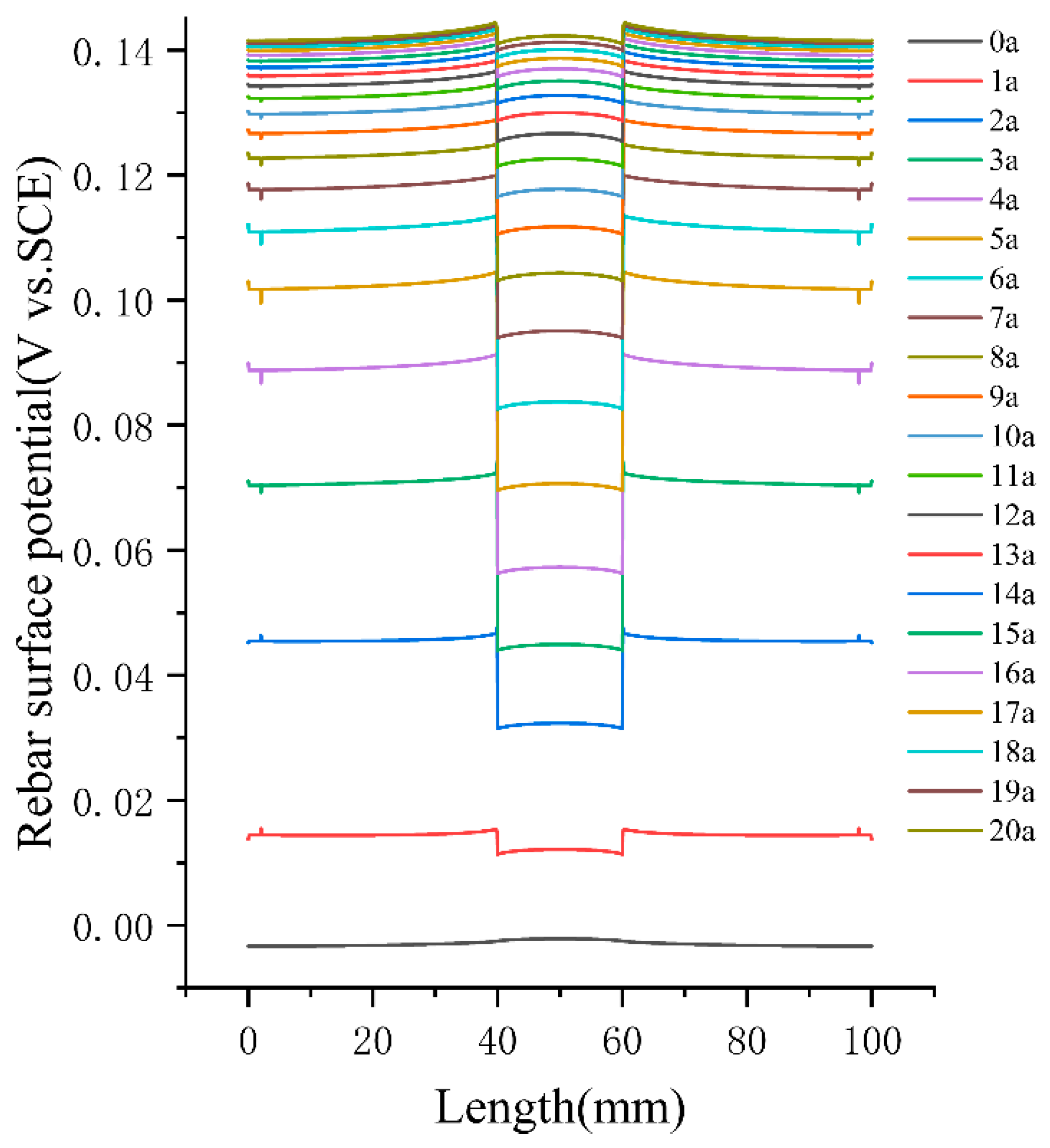
| NaCl | MgCl2·H2O | Na2SO4 | CaCl2 | KCl |
|---|---|---|---|---|
| 24.5 | 11.1 | 4.1 | 1.2 | 0.7 |
| Concrete | Coral Aggregate | Coral Sands | Seawater | Water Reducer |
|---|---|---|---|---|
| 557 | 749 | 749 | 195 | 11 |
| Depth x (mm) | Cf | |||||||
|---|---|---|---|---|---|---|---|---|
| 30 Days | 60 Days | 90 Days | 120 Days | 150 Days | 180 Days | 270 Days | 360 Days | |
| 2.5 | 0.3112 | 0.4749 | 0.5848 | 0.6326 | 0.7008 | 0.7556 | 0.9139 | 0.8363 |
| 7.5 | 0.2212 | 0.3470 | 0.4254 | 0.4511 | 0.4935 | 0.5427 | 0.6221 | 0.6541 |
| 12.5 | 0.1541 | 0.2429 | 0.2943 | 0.3043 | 0.3269 | 0.3676 | 0.4547 | 0.4921 |
| 17.5 | 0.1131 | 0.1691 | 0.1999 | 0.2010 | 0.2112 | 0.2411 | 0.3213 | 0.3587 |
| 22.5 | 0.0925 | 0.1234 | 0.1401 | 0.1380 | 0.1416 | 0.1610 | 0.2244 | 0.2571 |
| 27.5 | 0.0840 | 0.0988 | 0.1069 | 0.1046 | 0.1055 | 0.1163 | 0.1600 | 0.1854 |
| Times/Days | 30 | 60 | 90 | 120 | 150 | 180 | 270 | 360 |
|---|---|---|---|---|---|---|---|---|
| Cs/% | 0.361 | 0.544 | 0.670 | 0.730 | 0.812 | 0.869 | 0.914 | 0.931 |
| Times/Days | 30 | 60 | 90 | 120 | 150 | 180 | 270 | 360 |
|---|---|---|---|---|---|---|---|---|
| D (10−12 m2s−1) | 24.145 | 015.156 | 8.946 | 6.743 | 6.543 | 6.106 | 5.844 | 5.133 |
| Dry and Wet Cycle Time/Days | Ba/mV | Bc/mV | Icorr/μA·cm−2 | Ecorr/mV | Rp/Ω·cm2 |
|---|---|---|---|---|---|
| 120 | 137.65 | 160.24 | 5.73 × 10−5 | −491.06 | 5.61 × 105 |
| 180 | 124.95 | 114.24 | 6.10 × 10−5 | −367.39 | 4.25 × 105 |
| 240 | 101.87 | 112.51 | 5.37 × 10−5 | −428.70 | 3.15 × 105 |
| 300 | 75.39 | 79.12 | 5.25 × 10−5 | −559.00 | 3.19 × 105 |
| 360 | 75.04 | 94.80 | 5.79 × 10−5 | −477.75 | 3.14 × 105 |
| Dry and Wet Cycle Time/Days | Ba/mV | Bc/mV | Icorr/μA·cm−2 | Ecorr/mV | Rp/Ω·cm2 |
|---|---|---|---|---|---|
| 120 | 130.98 | 153.17 | 4.84 × 106 | −540.87 | 6.33 × 106 |
| 180 | 122.04 | 146.45 | 5.43 × 106 | −623.29 | 5.33 × 106 |
| 240 | 114.70 | 129.17 | 6.29 × 106 | −429.02 | 4.20 × 106 |
| 300 | 70.39 | 162.47 | 5.74 × 106 | −457.67 | 3.71 × 106 |
| 120 | 62.53 | 123.14 | 5.36 × 106 | −407.74 | 3.36 × 106 |
| Parameters | Symbols | Value |
|---|---|---|
| Geometric model length (mm) | L | 100 |
| Protective layer thickness (mm) | C | 30 |
| Diffusion coefficient of Cl− within CAC () | Controlled by Equation (3) | |
| Ultimate current density () | 1.5 | |
| Anodic Tafel slope () | Controlled by Equation (4) | |
| Cathodic Tafel slope () | −0.18 | |
| Anode exchange current density () | 300 | |
| Cathode exchange current density () | 10 | |
| Anode equilibrium potential (V vs. SCE) | −0.78 | |
| Cathode equilibrium potential (V vs. SCE) | 0.16 | |
| OH− initial concentration () anode equilibrium potential | 138.4 | |
| Cl− initial concentration () | 0 | |
| Fe2+ initial concentration () | 0 | |
| Na+ initial concentration () | 38.9 | |
| Ca2+ initial concentration () | Controlled by electrically neutral conditions | |
| Electrolyte potential in concrete (V vs. SCE) | 0 |
Disclaimer/Publisher’s Note: The statements, opinions and data contained in all publications are solely those of the individual author(s) and contributor(s) and not of MDPI and/or the editor(s). MDPI and/or the editor(s) disclaim responsibility for any injury to people or property resulting from any ideas, methods, instructions or products referred to in the content. |
© 2023 by the authors. Licensee MDPI, Basel, Switzerland. This article is an open access article distributed under the terms and conditions of the Creative Commons Attribution (CC BY) license (https://creativecommons.org/licenses/by/4.0/).
Share and Cite
Cao, H.; Wu, Q.; Akbar, M.; Yang, N.; Hussain, Z. Protective Performance of Coated Reinforcement in Coral Concrete under Dry/Wet Cycling. Materials 2023, 16, 4037. https://doi.org/10.3390/ma16114037
Cao H, Wu Q, Akbar M, Yang N, Hussain Z. Protective Performance of Coated Reinforcement in Coral Concrete under Dry/Wet Cycling. Materials. 2023; 16(11):4037. https://doi.org/10.3390/ma16114037
Chicago/Turabian StyleCao, Hongji, Qing Wu, Muhammad Akbar, Ning Yang, and Zahoor Hussain. 2023. "Protective Performance of Coated Reinforcement in Coral Concrete under Dry/Wet Cycling" Materials 16, no. 11: 4037. https://doi.org/10.3390/ma16114037
APA StyleCao, H., Wu, Q., Akbar, M., Yang, N., & Hussain, Z. (2023). Protective Performance of Coated Reinforcement in Coral Concrete under Dry/Wet Cycling. Materials, 16(11), 4037. https://doi.org/10.3390/ma16114037






